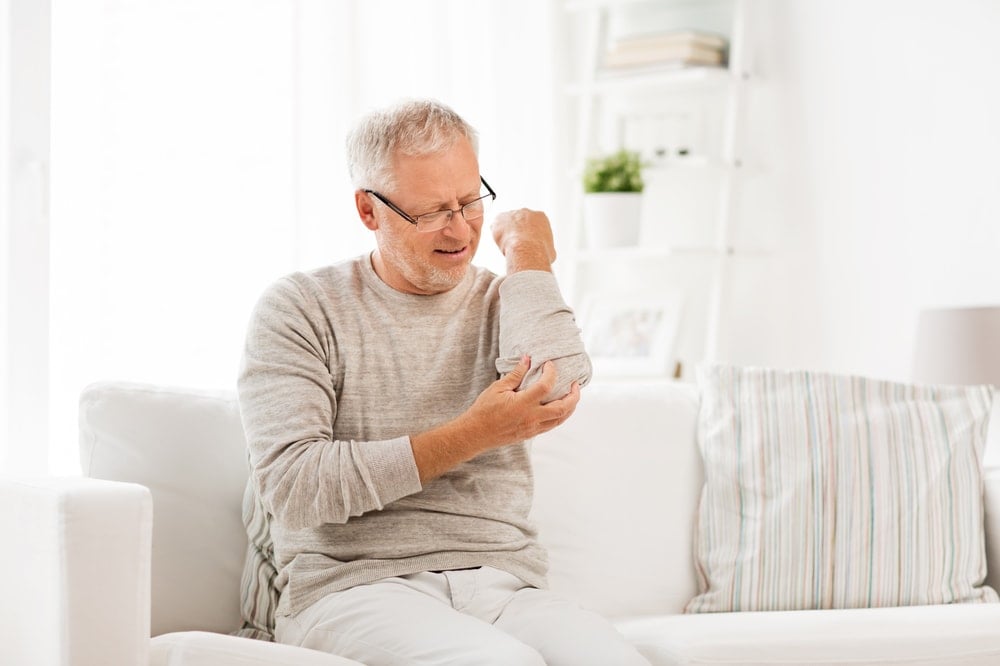Cómo la gota puede afectar el codo y el brazo
La gota en el codo no es muy común, pero para quienes la padecen, generalmente comienza y permanece concentrada en el dedo gordo del pie o en el área del pie durante un ataque inflamatorio. Para algunas personas, a medida que la enfermedad avanza con los años, puede ascender por el cuerpo y afectar las rodillas, los brazos, los dedos y los codos. Un primer ataque de gota en el codo es extremadamente raro, por lo que generalmente se ve en alguien que ha vivido con gota durante 10 a 15 años. A menudo, una convulsión afectará a otra articulación, como el dedo gordo del pie y el codo o el dedo gordo del pie y la rodilla.
El codo está formado por tres huesos, dos de los cuales pertenecen al antebrazo llamados radio y cúbito. El tercer hueso se llama húmero, que también es el hueso más grande y único en la parte superior del brazo. El húmero es muy importante ya que es el encargado de levantar, lanzar y escribir. Los cristales de ácido úrico generalmente se depositarán en el medio donde los tres huesos se conectan en la cápsula de la articulación del codo.
Un ataque de gota en el codo también ocurrirá inesperadamente, se despertará por la mañana y descubrirá que su codo está repentinamente hinchado y doloroso. Sentirá dolor y sensibilidad intensos, al igual que el dedo gordo del pie, su codo estará extremadamente sensible a cualquier presión, incluso una sábana. Su codo puede verse rojo, caliente e hinchado como si estuviera hinchado. La movilidad de su brazo obviamente será limitada. La piel de su codo puede pelarse y descamarse debido al enrojecimiento. También puede causar picazón.
El médico puede prescribir. colchicina o AINEs para eliminar el dolor y la inflamación y ponerlo en un tratamiento a largo plazo para controlar el ácido úrico, como allopurinol para evitar cualquier crisis futura.
La diferencia entre gota y bursitis.
Otra condición que puede afectar el codo y confundirse con gota es la bursitis. Ambos tienen síntomas similares, por eso es importante consultar a un médico si tiene un codo inflamado para ser diagnosticado y tratado adecuadamente. La bursitis es una afección que afecta los pequeños sacos llenos de líquido que protegen los huesos (llamados becas), tendones y músculos cerca de las articulaciones. Cuando los pequeños sacos se inflaman, la bursitis ocurre cerca de las articulaciones que realizan movimientos repetitivos frecuentes, como la rodilla, la cadera, el hombro, el talón y el codo. Además, la bursitis es una afección que requiere principalmente reposo para tratarse.
Otras condiciones que pueden hacerle pensar que es gota pero podrían ser otra cosa; La compresión del nervio puede causar dolor en el codo causado por aplastamiento o atrapamiento de los nervios. La artritis reumatoide u osteoartritis que afecta la articulación del codo puede provocar rigidez, dolor e inflamación en el codo y el brazo. ¡Así que presta atención a eso!
Tenga en cuenta que las personas con gota, artritis reumatoide o diabetes tienen un mayor riesgo de desarrollar bursitis. También tenga en cuenta que una complicación de la bursitis que a veces afecta el dedo gordo del pie es el desarrollo de un juanete. Un juanete es una hinchazón dolorosa en la primera articulación del dedo gordo del pie. Por lo general, aparecerá una protuberancia ósea. Se forma cuando el dedo gordo del pie empuja contra el siguiente, lo que obliga a la articulación del dedo gordo del pie a agrandarse y sobresalir. Esto también se puede confundir con la gota y es muy importante controlarlo.
En algunos casos, la cirugía puede usarse para tratar las articulaciones del codo afectadas por la gota. Si el tratamiento médico, la dieta y otros tratamientos han fallado y hay daño en la articulación del codo, es posible que se necesite cirugía. Hay tres cirugías principales para tratar la gota en el codo:
- cirugía para Tofos: tofo en casos avanzados de gota de codo.
- Cirugía para la fusión de las articulaciones del codo con el fin de volver a conectarlas después de la destrucción y el daño.
- Cirugía para el reemplazo de la articulación del codo si la articulación está demasiado dañada para repararla y debe reemplazarse por completo con una articulación artificial.
En conclusión, una cosa es segura. Si desarrolla gota en el codo, generalmente significa que su tratamiento para la gota no funcionó o tal vez simplemente se saltó el tratamiento. Esto debería hacer sonar la alarma e inspirarlo a realizar los cambios necesarios en su estilo de vida, dieta y tratamiento médico”.

